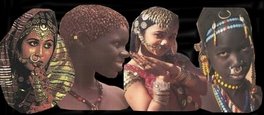Pprehistory
Archaeological excavation of archaeological sites on the Nile above Aswan has confirmed human habitation in the river valley during the Paleolithic period that spanned more than 60,000 years of Sudanese history. A prehistoric burial discovered in northern Sudan reveals what is believed to be the world's earliest indication of warfare, dating to the 12th millennium BC [1]. By the eighth millennium B.C., people of a Neolithic culture had settled into a sedentary way of life there in fortified mud-brick villages, where they supplemented hunting and fishing on the Nile with grain gathering and cattle herding. Anthropological and archaelogical research indicate that during the predynastic period Nubia and Nagadan Upper Egypt were ethnically, and culturally nearly identical, and thus, simultaneously evolved systems of pharaonic kingship by 3300 BC. [2] But during the close of the Nagada III period, Nagada, in its bid to conquer and unify the whole nile valley, seems to have conquered their southern neighbors and thus, "egyptianized" them. [3]. The result appears to have been the depopulation of the entire Lower Nubian area, either by the genocidal efforts of the First Dynasty Egyptian kings, or by the migration (forced or voluntary) of the nubians to areas north and south.
Kush
Northern Sudan's earliest historical record comes from Egyptian sources, which described the land upstream from the First Cataract, called Kush, as "wretched." For more than 2,000 years after the Old Kingdom (ca. 2700-2180 B.C.), Egyptian political and economic activities determined the course of the central Nile region's history. Even during intermediate periods when Egyptian political power in Kush waned, Egypt exerted a profound cultural and religious influence on the Kushite people.
Over the centuries, trade developed. Egyptian caravans carried grain to Kush and returned to Aswan with ivory, incense, hides, and carnelian (a stone prized both as jewelry and for arrowheads) for shipment downriver. Egyptian traders particularly valued gold and slaves, who served as domestic servants, concubines, and soldiers in the pharaoh's army. Egyptian military expeditions penetrated Kush periodically during the Old Kingdom. Yet there was no attempt to establish a permanent presence in the area until the Middle Kingdom (ca. 2100-1720 B.C.), when Egypt constructed a network of forts along the Nile as far south as Samnah, in southern Egypt, to guard the flow of gold from mines in Wawat.
Around 1720 B.C., Asian nomads called Hyksos invaded Egypt, ended the Middle Kingdom, severed links with Kush, and destroyed the forts along the Nile River. To fill the vacuum left by the Egyptian withdrawal, a culturally distinct indigenous kingdom emerged at Karmah, near present-day Dunqulah. After Egyptian power revived during the New Kingdom (ca. 1570-1100 B.C.), the pharaoh Ahmose I incorporated Kush as an Egyptian province governed by a viceroy. Although Egypt's administrative control of Kush extended only down to the fourth cataract, Egyptian sources list tributary districts reaching to the Red Sea and upstream to the confluence of the Blue Nile and White Nile rivers. Egyptian authorities ensured the loyalty of local chiefs by drafting their children to serve as pages at the pharaoh's court. Egypt also expected tribute in gold and slaves from local chiefs.
Once Egypt had established political control over Kush, officials and priests joined military personnel, merchants, and artisans and settled in the region. The Egyptian language became widely used in everyday activities. The Kushite elite adopted Egyptian gods and built temples like that dedicated to the sun god Amon at Napata, near present-day Kuraymah. The temples remained centers of official religious worship until the coming of Christianity to the region in the sixth century. When Egyptian influence declined or succumbed to foreign domination, the Kushite elite regarded themselves as champions of genuine Egyptian cultural and religious values.
By the eleventh century B.C., the authority of the New Kingdom dynasties had diminished, allowing divided rule in Egypt, and ending Egyptian control of Kush. There is no information about the region's activities over the next 300 years. In the eighth century B.C., however, Kush reemerged as an independent kingdom ruled from Napata by an aggressive line of monarchs who gradually extended their influence into Egypt. About 750 B.C., a Kushite king called Kashta conquered Upper Egypt and became ruler of Thebes until approximately 740 B.C. His successor, Piankhy, subdued the delta, reunited Egypt under the Twenty-fifth Dynasty, and founded a line of kings who ruled Kush and Thebes for about a hundred years. The dynasty's intervention in the area of modern Syria caused a confrontation between Egypt and Assyria. When the Assyrians in retaliation invaded Egypt, Taharqa (688-663 B.C.), the last Kushite pharaoh, withdrew and returned the dynasty to Napata, where it continued to rule Kush and extended its dominions to the south and east.Kush was known as the mother of gold.
Meroe
Egypt's succeeding dynasty failed to reassert control over Kush. In 590 B.C., however, an Egyptian army sacked Napata, compelling the Kushite court to move to a more secure location at Meroe near the Sixth Cataract. For several centuries thereafter, the Meroitic kingdom developed independently of Egypt, which passed successively under Persian, Greek, and, finally, Roman domination. During the height of its power in the second and third centuries B.C., Meroe extended over a region from the third cataract in the north to Sawba, near present-day Khartoum, in the south.
The pharaonic tradition persisted among a line of rulers at Meroe, who raised stelae to record the achievements of their reigns and erected pyramids to contain their tombs. These objects and the ruins of palaces, temples, and baths at Meroe attest to a centralized political system that employed artisans' skills and commanded the labor of a large work force. A well-managed irrigation system allowed the area to support a higher population density than was possible during later periods. By the first century B.C., the use of hieroglyphs gave way to a Meroitic script that adapted the Egyptian writing system to an indigenous, Nubian-related language spoken later by the region's people. Meroe's succession system was not necessarily hereditary; the matriarchal royal family member deemed most worthy often became king. The queen mother's role in the selection process was crucial to a smooth succession. The crown appears to have passed from brother to brother (or sister) and only when no siblings remained from father to son.
Although Napata remained Meroe's religious center, northern Kush eventually fell into disorder as it came under pressure from the Blemmyes, predatory nomads from east of the Nile. However, the Nile continued to give the region access to the Mediterranean world. Additionally, Meroe maintained contact with Arab and Indian traders along the Red Sea coast and incorporated Hellenistic and Hindu cultural influences into its daily life. Inconclusive evidence suggests that metallurgical technology may have been transmitted westward across the savanna belt to West Africa from Meroe's iron smelteries.
Relations between Meroe and Egypt were not always peaceful. In 23 B.C., in response to Meroe's incursions into Upper Egypt, a Roman army moved south and razed Napata. The Roman commander quickly abandoned the area, however, as too poor to warrant colonization.
In the second century A.D., the Nobatae occupied the Nile's west bank in northern Kush. They are believed to have been one of several well-armed bands of horse- and camel-borne warriors who sold protection to the Meroitic population; eventually they intermarried and established themselves among the Meroitic people as a military aristocracy. Until nearly the fifth century, Rome subsidized the Nobatae and used Meroe as a buffer between Egypt and the Blemmyes. Meanwhile, the old Meroitic kingdom contracted because of the expansion of the powerful Ethiopian Kingdom of Aksum to the east. By A.D. 350, King Ezana of Axum had captured and destroyed Meroe city, ending the kingdom's independent existence, and conquering its territory into modern-day southern Egypt.Meroe was considered a wheel because all trade routes led to meroe.




![[Pyramids from the Northern Cemetery at Meroe]](http://www.hp.uab.edu/image_archive/um/pyramid01-th.jpg)
![[Ruins of Merotic temple at Musawwarat es-Sufra]](http://www.hp.uab.edu/image_archive/um/architecture04-th.jpg)
![[Elephant statue from the Great Enclosure at Musawwarat es-Sufra temple]](http://www.hp.uab.edu/image_archive/um/architecture05-th.jpg)
![[Queen Shanadakhete's inscription]](http://www.hp.uab.edu/image_archive/um/relief06-th.jpg)
![[Queen Amanirenas' stele]](http://www.hp.uab.edu/image_archive/um/inscription01-th.jpg)
![[Relief from a stand at Wad Ban Naga temple showing Queen Amanitare, wife Natakamani]](http://www.hp.uab.edu/image_archive/um/relief04-th.jpg)
![[Relief from the Lion Temple at Naga, south of Meroe]](http://www.hp.uab.edu/image_archive/um/relief05-th.jpg)
![[Kiosk at Naga, South of Meroe]](http://www.hp.uab.edu/image_archive/um/architecture06-th.jpg)
![[The Lion Temple of Naqa, Meroe]](http://www.hp.uab.edu/image_archive/um/architecture07-th.jpg)
![[Rear view of the Lion Temple, Naqa, Mero. Relief of Apedemek]](http://www.hp.uab.edu/image_archive/um/architecture08-th.jpg)
![[Apedemek from the Lion Temple, Naqa, Meroe]](http://www.hp.uab.edu/image_archive/um/name01-th.jpg)
![[Ba statue of a woman, Meroe]](http://www.hp.uab.edu/image_archive/um/statue07-th.jpg)
![[Gold jackal. Mero]](http://www.hp.uab.edu/image_archive/um/gold01-th.jpg)
![[Bronze vessels from Merotic graves at Faras]](http://www.hp.uab.edu/image_archive/um/bronze04-th.jpg)
![[Redware amphora from a Merotic grave at Faras]](http://www.hp.uab.edu/image_archive/um/pottery11-th.jpg)
![[Burnished black ware from Meroe]](http://www.hp.uab.edu/image_archive/um/pottery09-th.jpg)
![[Decorated Merotic cups from Faras]](http://www.hp.uab.edu/image_archive/um/pottery10-th.jpg)
![[Ring flask from a Merotic grave at Faras]](http://www.hp.uab.edu/image_archive/um/pottery08-th.jpg)
![[Meroitic utility redware from a grave at Faras]](http://www.hp.uab.edu/image_archive/um/pottery12-th.jpg)
![[Tomb of a Merotic aristocrat at Faras]](http://www.hp.uab.edu/image_archive/um/tomb01-th.jpg)











1 comment:
Nice Topic
Post a Comment